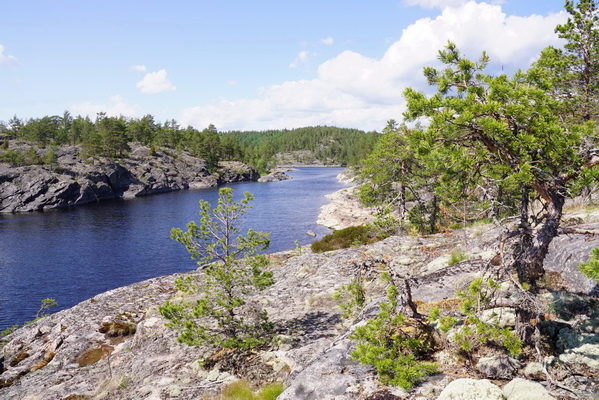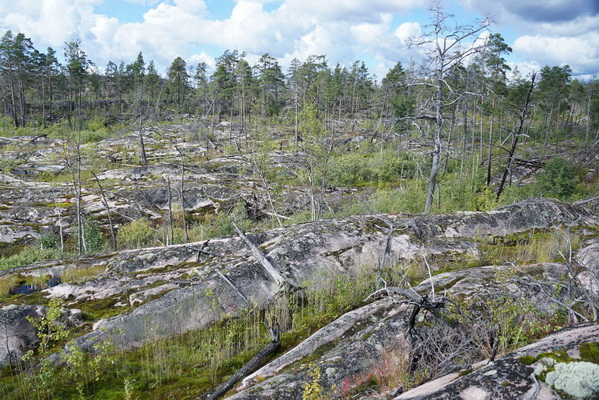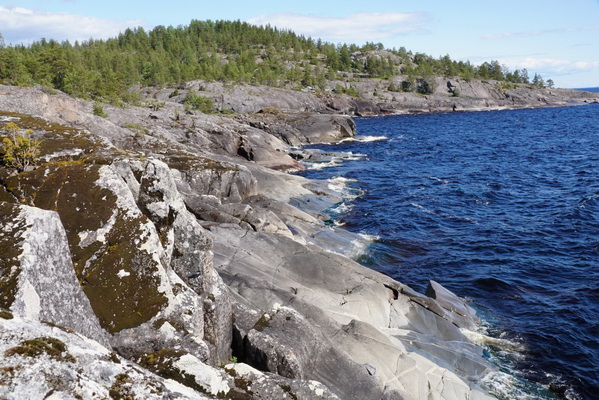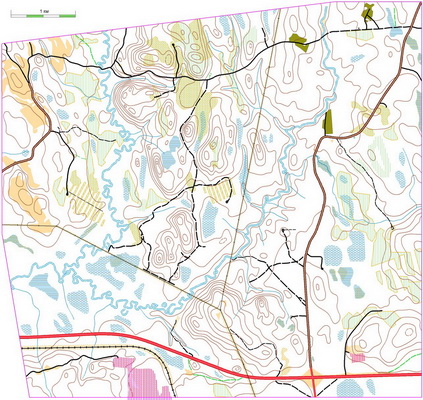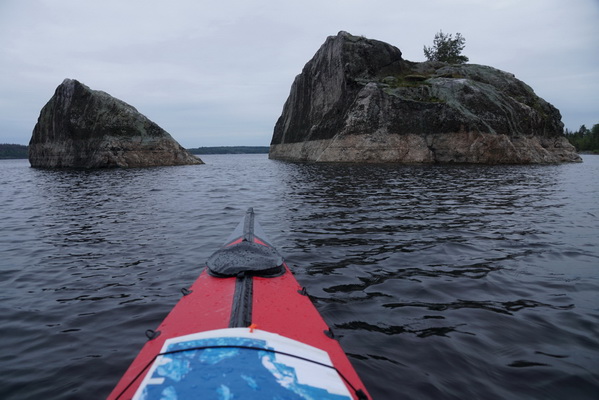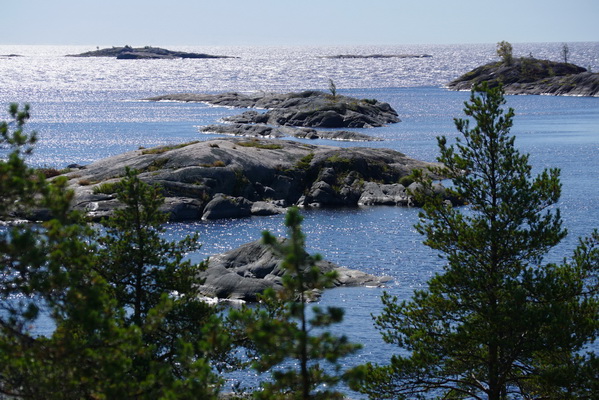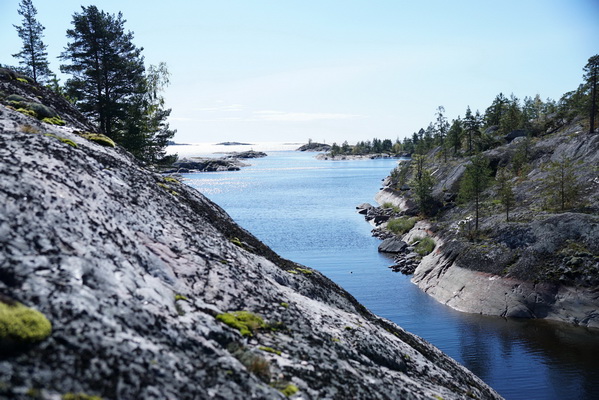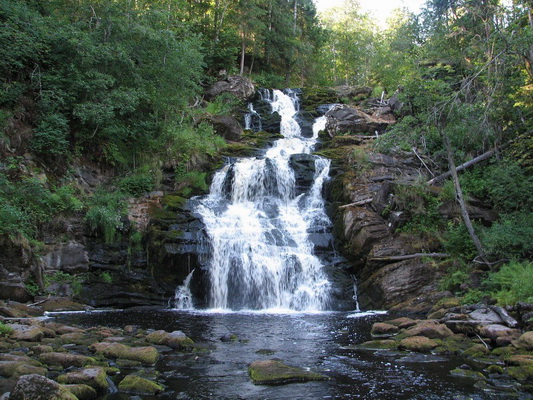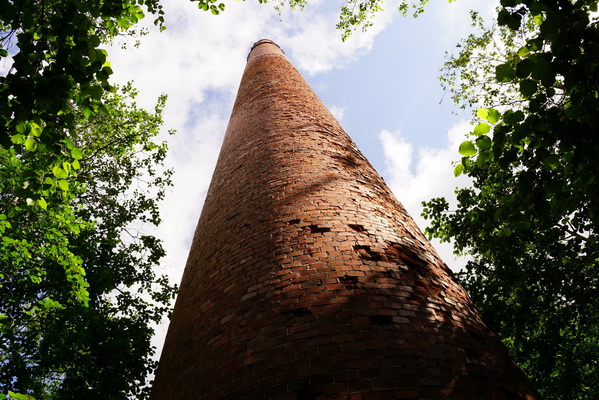STAGES
District of the trekking routes is very various. The hills up to 90 m height covered with forest which passability varies from very easy to seriously hard. In places there are the pine woods of park type, sometimes there is a windbreak with already grown underbrush. But there are only a few heavy going spots. You can find many rock outlets like Bare rocks (rock formations) or cliffs up to 30 m height. They are very slippery when it’s rainy! The moss covering rocks slides off as soaped. So you should be very careful! Some part of routes will pass on tracks and roads, but the main distance lies out of tracks. Two small routes of five will be very unusual. They are located on the capes that jut out into Ladoga Lake. One of them is partly and the second are fully flat granite hills without any forest or with pure well looked through wood and different relief forms: from small to the large. For these routes will be distributed the special hybrid maps at Team’s Registration (the sample will be published later). Here you can feel in full the severe and picturesque nature of Karelia. The organisers tried to choose the most beautiful points for check points on these routes. Two of them took a status of “Spot of force”. If you participated in the previous Red Fox Adventure Races, you know what it means and certainly remember the feeling of an unusual spiritual state which appeared there. The various and unexpectedly changing relief will demand of constant, forceful drive and exact orienteering from the racers. There are the detailed maps in scale 1:10000 and 1:20000 for all five routes. Partly the trekking routes will include coastering which mentioned below.
Recommended equipment for walking stage:
1. Clothing according to the forest conditions and weather
2. Footwear with metal crampons
3. Trekking poles
4. Food reserve for this stage
5. Insect repellent. There can be a lot of mosquitoes!
Mesh or mosquito net will allow you to sleep in the forest
This year the distances are lied such way that the visibility of control points can be very low, from one to twenty meters. But, please, be calm! The control points are not hidden. You don’t need to look for check point in each small crack. There are hundreds of cracks in this area. To find check point it‘s necessary to carry out accurately the following rules:
1. Go in direction specified by arrows in the map and exactly as it is shown by a red dashed line.
2. Move along the coast close to the water as that you are able to observe a water edge. However, check point cannot be located under the cliffed and impassable, steep inclined rock walls. You should go round them above. Swimming isn’t intended.
3. If you go round the rocky steeps above, it’s necessary to choose the possible lowermost way. You don’t need to apply rock climbing but in places you should use your arms!
Rocks and stones are very slippery when it’s rainy! You can be sure on these routes only equipped by footwear with crampons. It’s recommended the trekking poles.
Personal mandatory equipment for mountain bike stage:
1. Mountain bike with rear red light
2. Helmet
3. Bike gloves
4. Bike map-board on handlebar
5. Maps (received at Team registration)
6. Team’s number (given by organizers at Team registration) must be fixed at the front of the bike
Recommended equipment for mountain bike stage:
1. Clothing according to the weather
2. Spare tube for each team’s member
3. Bicycle repair kit
4. Food reserve for this stage
The islands and skerries will protect the most part of routes from the wind of all directions excluding a south wind. But you should know that the skerries are not narrow and sometimes have a width more than 1 km. Some part of routes goes along the coast of open Ladoga Lake where even a weak wind creates a good wave. Daytime breeze on Ladoga Lake in summer time is a natural occurrence. The tranquil waters of the Lake are usually along towards evening and up to 10 a.m. In case of strong wave the paddling routes can be postponed for later time. In case of settled storm which probability isn't great the paddling routes will be cancelled partially or completely. If this occurs, it will be realized the spare regulations about passing of other routes. It’ll be specified in the route sheet particularly. The decision in these cases will be concluded by the organisers during the race in accordance with each concrete situation. Mean water temperature in open Ladoga Lake is 8°C in June. In gulfs with shallow waters it can reach 18-20°С. During two paddling routes you should once leave your kayak in the transition area and get out to the shore for passing short walking routes.
Team mandatory equipment for paddling stage:
1. For teams of 2 racers: Two-seat kayak and pair of paddles.
2. For teams of 4 racers: 2 two-seat kayaks and 2 pairs of paddles. It’s allowed a kayak of any model. The kayak should be equipped with floatation bags corresponding to kayak’s model. The kayak should have all standard details of frame in good repair.
3. Map and route sheet (received at Team registration).
4. Kayak repair kit in case of damage a kayak cover.
Personal mandatory equipment for paddling stage:
1. Life vest
2. Skirt
Recommended equipment for paddling stage:
1. Map-board of А3 format
2. Non-sliping gloves
3. Clothing according to the weather and additional spare set of clothing packed in dry bag
4. Food reserve for this stage
In some cases the participants will be provided by equipment from the race organizers on these routes, sometimes they should use their own personal equipment and team rope.
Order of fixed rope routes passing will be described in the Route sheet.
Successful overcoming of fixed rope routes requires the following skills:
1. Rappelling and climbing by vertical or steep inclined fixed rope. Change the way of moving during the route. Climbing height can be up to 15 m, descent – up to 35 m.
2. Overcoming of horizontal or slightly inclined air portage – cable of big diameter - without alpine equipment.
3. Climbing by vertical wall, metal steps (stirrups) up to 35 m height.
There will be natural (tree trunks) belay points and anchors (bolts) marked by orange tape in the places of rope fixing or self-belaying.
Participants can use only these belay points!
The judges will control some fixed rope stages (the most complex ones). Each competitor has to obey strictly to all judge’s requirements.
Judges have a right to give a penalty or disqualify the team from the route passing in following cases: competitor has an accident, competitor doesn’t obey to judge’s requirements, skip of the safety rules, in case of obvious inadequate state of competitor.
There will be a test rope route in the Race center prior the race start. All teams have to pass it before the Team’s registration. During that test stage competitors should hang the team rope and rappel by inclined rock wall of about 10 m height up to check point and climb then. Time of passing is limited for the team. It will not be very strict time limit, but not very tender too. The exact time will be announced at the start of test course. Teams staying out of the control time will not be admitted to the most difficult rope stage at the Race.
Personal mandatory equipment for fixed ropes stages:
1. Harness
2. Helmet
3. 2 lanyards
4. Carabiners 3 pcs.
5. Descender. It’s recommended: reverso, atc and others. Figure-eight descender is admitted.
6. Rope clamp - 2 pcs. It could be a jumar, baisic, croll, pantin. Prusik knots are forbidden.
7. Tradle for jumar
8. Clothing protecting elbows and knees
Recommended personal equipment for fixed ropes stages:
1. Additional sling 80 cm.
Team mandatory equipment for fixed ropes stages:
1. Rope of 20 m long, not less than 9 mm thickness.
It’s recommended static rope. The dynamic is allowed too.
Personal mandatory equipment for swimming stage:
1. Life vest
During the whole race all the teams must have the following general team mandatory equipment:
1. First aid kit in sealed package. It includes: Bandage of 6 cm width - 2 pcs. Plaster of min 3 cm width. Anaesthetic (like paracetamol and others). Anti-inflammatory (like ibuprofen and others). Aseptic bandage and cotton wool – 1 pcs.
2. Knife
3. Matches in sealed package
4. Mobile phone fully charged in sealed package
During the whole race all team’s members must have the following personal mandatory equipment:
1. Compass
2. Whistle
3. Light with a double stock of batteries
Recommended equipment for walking stage:
1. Clothing according to the forest conditions and weather
2. Footwear with metal crampons
3. Trekking poles
4. Food reserve for this stage
5. Insect repellent. There can be a lot of mosquitoes!
Mesh or mosquito net will allow you to sleep in the forest
Coastering stage
Coastering is a special type of walking route which assumes passing of check points that are not marked in the maps. You can find its following on coast of the lake, sea or other reservoir specified in the map. There are two coastering routes along Ladoga Lake. They will be part of walking routes. So their distance will not be pointed. The area of coastering stage includes granite, free from vegetation rock places of the coast. Sometimes it’s the narrow zones along the lake covered with boulders of different size, in places there are flat and slightly sloping rocky banks or destroyed rocks that are very hard for movement and rocky steeps up to 20 meters height.This year the distances are lied such way that the visibility of control points can be very low, from one to twenty meters. But, please, be calm! The control points are not hidden. You don’t need to look for check point in each small crack. There are hundreds of cracks in this area. To find check point it‘s necessary to carry out accurately the following rules:
1. Go in direction specified by arrows in the map and exactly as it is shown by a red dashed line.
2. Move along the coast close to the water as that you are able to observe a water edge. However, check point cannot be located under the cliffed and impassable, steep inclined rock walls. You should go round them above. Swimming isn’t intended.
3. If you go round the rocky steeps above, it’s necessary to choose the possible lowermost way. You don’t need to apply rock climbing but in places you should use your arms!
Rocks and stones are very slippery when it’s rainy! You can be sure on these routes only equipped by footwear with crampons. It’s recommended the trekking poles.
Mountain bike stage
Race area has developed enough road network. The maps are prepared specially for the Red Fox Adventure Race 2016. Maps in scale 1:50000 (1 cm on map relates to 500 m on ground). There are 6 types of roads: asphalt roads, gravel roads (wide, covered by broken stones), stabilized roads (forest roads covered in places by broken stones), dirt roads, trails, paths. 90% of roads where will pass the routes can be described as high-speed. But speed can slightly decrease here when it’s rainy. The distances lie in hill area where the difference in height at one ascent could be up to 60 m. Traffic on asphalt and gravel roads is from low to average intensity during the daytime and low at night. Total length of these roads is 30% of all race distance. Racers should take into account their physical and mental state and not come out to roads with vehicular traffic in condition of overfatigue. Check points can be located at distance up to 100 m from the road.Personal mandatory equipment for mountain bike stage:
1. Mountain bike with rear red light
2. Helmet
3. Bike gloves
4. Bike map-board on handlebar
5. Maps (received at Team registration)
6. Team’s number (given by organizers at Team registration) must be fixed at the front of the bike
Recommended equipment for mountain bike stage:
1. Clothing according to the weather
2. Spare tube for each team’s member
3. Bicycle repair kit
4. Food reserve for this stage
Paddling stage
Paddling routes will pass in wonderful places of northern part of Ladoga Lake. Extended skerries with many grey granite Bare rocks and dozens of well favoured large and small islands behind which you will see the horizonless vast of great Lake. It’s the most beautiful and fascinating race routes. Therefore, the race will start from the paddling stage. On some of check points you can mark without getting out of the kayak, but sometimes it’s necessary to come ashore. It’ll be reasonable to choose paddling round or small portage in two places. The order of check points and routes is planned to avoid a queue during the marking.The islands and skerries will protect the most part of routes from the wind of all directions excluding a south wind. But you should know that the skerries are not narrow and sometimes have a width more than 1 km. Some part of routes goes along the coast of open Ladoga Lake where even a weak wind creates a good wave. Daytime breeze on Ladoga Lake in summer time is a natural occurrence. The tranquil waters of the Lake are usually along towards evening and up to 10 a.m. In case of strong wave the paddling routes can be postponed for later time. In case of settled storm which probability isn't great the paddling routes will be cancelled partially or completely. If this occurs, it will be realized the spare regulations about passing of other routes. It’ll be specified in the route sheet particularly. The decision in these cases will be concluded by the organisers during the race in accordance with each concrete situation. Mean water temperature in open Ladoga Lake is 8°C in June. In gulfs with shallow waters it can reach 18-20°С. During two paddling routes you should once leave your kayak in the transition area and get out to the shore for passing short walking routes.
Team mandatory equipment for paddling stage:
1. For teams of 2 racers: Two-seat kayak and pair of paddles.
2. For teams of 4 racers: 2 two-seat kayaks and 2 pairs of paddles. It’s allowed a kayak of any model. The kayak should be equipped with floatation bags corresponding to kayak’s model. The kayak should have all standard details of frame in good repair.
3. Map and route sheet (received at Team registration).
4. Kayak repair kit in case of damage a kayak cover.
Personal mandatory equipment for paddling stage:
1. Life vest
2. Skirt
Recommended equipment for paddling stage:
1. Map-board of А3 format
2. Non-sliping gloves
3. Clothing according to the weather and additional spare set of clothing packed in dry bag
4. Food reserve for this stage
Fixed rope stages
There will be some check points during the mountain bike, paddling and trekking stages where you need to use alpine equipment pointed in the list of Mandatory equipment.In some cases the participants will be provided by equipment from the race organizers on these routes, sometimes they should use their own personal equipment and team rope.
Order of fixed rope routes passing will be described in the Route sheet.
Successful overcoming of fixed rope routes requires the following skills:
1. Rappelling and climbing by vertical or steep inclined fixed rope. Change the way of moving during the route. Climbing height can be up to 15 m, descent – up to 35 m.
2. Overcoming of horizontal or slightly inclined air portage – cable of big diameter - without alpine equipment.
3. Climbing by vertical wall, metal steps (stirrups) up to 35 m height.
There will be natural (tree trunks) belay points and anchors (bolts) marked by orange tape in the places of rope fixing or self-belaying.
Participants can use only these belay points!
The judges will control some fixed rope stages (the most complex ones). Each competitor has to obey strictly to all judge’s requirements.
Judges have a right to give a penalty or disqualify the team from the route passing in following cases: competitor has an accident, competitor doesn’t obey to judge’s requirements, skip of the safety rules, in case of obvious inadequate state of competitor.
There will be a test rope route in the Race center prior the race start. All teams have to pass it before the Team’s registration. During that test stage competitors should hang the team rope and rappel by inclined rock wall of about 10 m height up to check point and climb then. Time of passing is limited for the team. It will not be very strict time limit, but not very tender too. The exact time will be announced at the start of test course. Teams staying out of the control time will not be admitted to the most difficult rope stage at the Race.
Personal mandatory equipment for fixed ropes stages:
1. Harness
2. Helmet
3. 2 lanyards
4. Carabiners 3 pcs.
5. Descender. It’s recommended: reverso, atc and others. Figure-eight descender is admitted.
6. Rope clamp - 2 pcs. It could be a jumar, baisic, croll, pantin. Prusik knots are forbidden.
7. Tradle for jumar
8. Clothing protecting elbows and knees
Recommended personal equipment for fixed ropes stages:
1. Additional sling 80 cm.
Team mandatory equipment for fixed ropes stages:
1. Rope of 20 m long, not less than 9 mm thickness.
It’s recommended static rope. The dynamic is allowed too.
Swimming stage
For Long class one of check points of walking route will be located on the island. You can reach it only swimming of the lades of 30-70 m width between near-by islands. In total the distance of swimming is 300 m. Forecasting water temperature is 8°С. The racers should realize that overcoming of this place of distance in cold and windy weather can result in hypothermia. It’s obligatory to use a life vest here. It’s recommended by the organisers to use a diving suit for racers without enough experience. Moreover, the racers have to take water several times for reaching of check point on other routes.Personal mandatory equipment for swimming stage:
1. Life vest
During the whole race all the teams must have the following general team mandatory equipment:
1. First aid kit in sealed package. It includes: Bandage of 6 cm width - 2 pcs. Plaster of min 3 cm width. Anaesthetic (like paracetamol and others). Anti-inflammatory (like ibuprofen and others). Aseptic bandage and cotton wool – 1 pcs.
2. Knife
3. Matches in sealed package
4. Mobile phone fully charged in sealed package
During the whole race all team’s members must have the following personal mandatory equipment:
1. Compass
2. Whistle
3. Light with a double stock of batteries
